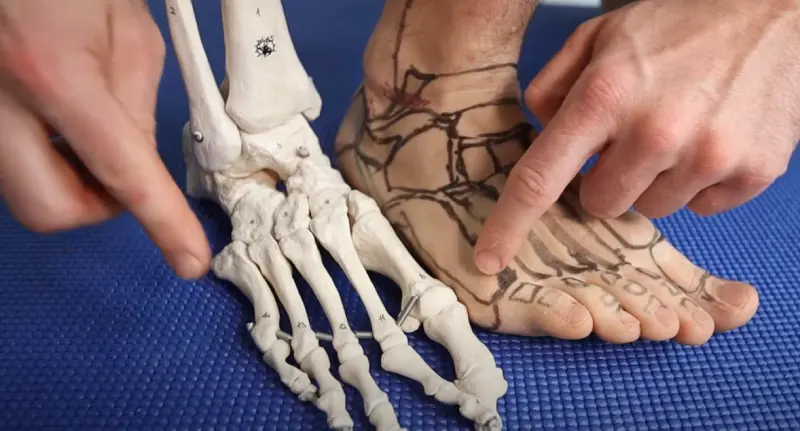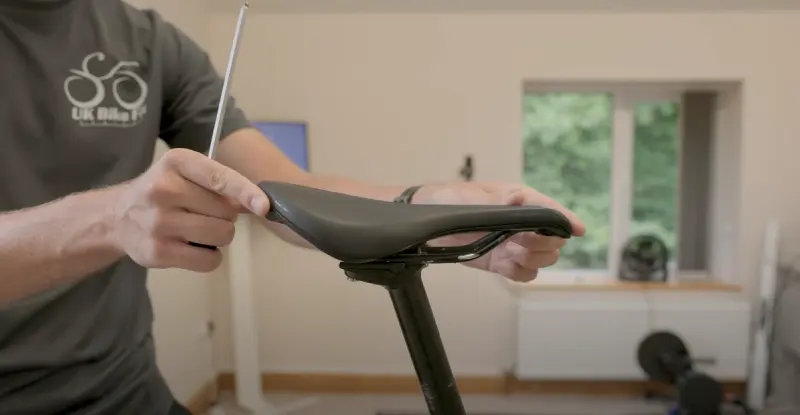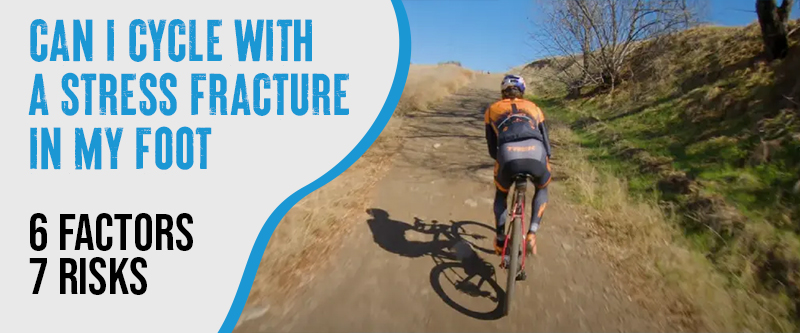Stress fractures are tiny cracks or bruises in the bone. Injuries like this can be painful and debilitating. The most common cause of stress fractures is overuse or repetitive actions, which are common in athletes, including cyclists.
It’s good to know that you can still participate in cycling activities even if you have a stress fracture, as long as you don’t experience pain during or after the workout.
I recommend wearing a walking boot while cycling to reduce pressure on the foot while pedaling. It’s essential to start slow and accumulate intensity to avoid worsening the stress fracture.
This article will delve deeper into cycling with an ankle stress fracture, its risks and complications, and factors to consider before embarking on a cycling journey with an ankle stress fracture.
Can I Cycle With a Stress Fracture In My Foot? 6 Risks

Stress fractures in the foot can be potentially dangerous and lead to further complications. Here are some potential risks and complications to remember:
- Delayed Healing: Cycling when fractured can delay the healing process and cause the fracture to worsen. The repetitive pedaling motion can stress the affected area, making it difficult for the bone to heal correctly.
- Increased Pain: Cycling while dealing with a stress fracture can be challenging. Cause increased pain and discomfort in the affected region. The repetitive cycling motion can worsen the fracture and damage the surrounding tissues.
- Risk of Further Injury: Cycling with a stress fracture will put you at risk for further injury, including a complete fracture or a stress reaction. It is essential to allow your foot to fully heal before resuming any high-affected activities.
- Compromised Balance: Cycling while you have foot stress fractures can compromise your balance and increase the risk of falls. This is true if the fracture occurs in a weight-bearing bone, such as the tibia or fibula.
- Nerve Damage: Cycling while you’ve got a stress fracture can pressure the surrounding nerves, causing nerve damage and numbness. This can lead to long-term complications and a longer recovery time.
- Chronic Pain: If a stress fracture cannot heal, it can cause chronic pain and discomfort. This can affect your daily life and limit the kinds of things you can do
- Decreased Range of Motion: Cycling with a stress fracture can reduce your foot’s range of motion, making it harder for you to return to normal activities.
Biking With a Stress Fracture In My Foot: 6 Factors To Consider

As a cycling enthusiast, it is natural to want to continue cycling, even when faced with a stress fracture. Some critical factors must be considered before you hop on your bike.
Type of Cycling
The type of cycling also affects your decision. If you’re an intense mountain biker, avoiding cycling until your fracture has healed completely is best. However, after consulting with your doctor, cycling may be possible if you’re into leisurely cycling.
Healing Progress
If your fracture is healing well, you can try to cycle slowly and for short distances. However, if you’re still experiencing pain and swelling, avoiding cycling until you fully heal is best.
The Severity of The Stress Fracture
Stress fracture severity is critical to consider before cycling. Stress fractures can range from mild to severe, and severe fractures can lead to long-term pain and complications. If you have a severe stress fracture, it’s best to avoid cycling altogether until your fracture has healed.
Location of the Fracture in Your Foot
The fracture location is another essential factor to consider before cycling. If your stress fracture is in a weight-bearing part of your foot, such as your heel or your metatarsals, cycling can additionally pressure the fracture, exacerbating your injury.
Type of Cycling Activity You Plan to Engage In
The type of cycling you plan on engaging in is also critical. Taking part in high-affected cycling activities such as mountain biking, cyclo-cross, or sprinting puts more stress on your feet and legs. Opting for low-affected cycling activities such as spin classes, slow casual biking, or using a stationary bike can help reduce the strain on your foot.
Your Level of Pain and Discomfort
The level of pain and discomfort in your foot is an excellent way to gauge whether you should cycle with a stress fracture on your foot. If you experience sharp, severe, or ongoing pain, cycling aggravates your injury and hinders your healing. Mild discomfort may allow you to continue cycling with caution.
4 Safety Measures to Take for Cycling with a Stress Fracture
Cycling can be a fantastic, low-impact exercise option for people with stress fractures in their feet. However, taking the right safety measures is crucial to ensure a swift recovery, causing no further damage to your injured foot. The following tips will help you:
Wear the right shoes and inserts
If you suffer from a stress fracture from cycling, wearing the right shoes and inserts is essential. Choose shoes that provide adequate support, stability, and cushioning. Ensure your inserts fit snugly and offer the right arch support to ease pressure on your foot. Investing in custom-made orthotics can also help prevent further injury while you cycle.
Adjust your bike setup and pedaling technique

The next step is to ensure your bike fits you correctly, minimizing the impact on your foot. Adjust your seat height and bike handle position to relieve pressure from your foot. You can also choose a low-affected exercise bike or a stationary bike with pedal straps to lessen the strain on your injured foot when cycling. Maintaining a steady, low-intensity pace and avoiding standing up on the pedals to prevent aggravating your injury is essential.
Choose low-affected cycling activities
While cycling is a great low-affected exercise, there are specific low-affected activities that are ideal for people with stress fractures. Consider using a recumbent bike or an exercise bike with a backrest if you’re concerned about balance and stability. Similarly, you can cycle on a flat surface rather than hilly terrains to reduce pressure on your foot. Opt for cycling activities that are comfortable and cause minimal pain or discomfort.
Follow The Advice Of Your Medical Professional
It is crucial to seek advice from a qualified medical professional before cycling after suffering from a stress fracture. Your doctor or physiotherapist will assess your injury and advise you on the best action. They may suggest anti-inflammatory medication or physical therapy to help you recover faster. You must follow their advice to avoid causing further harm to your foot.
Conclusion
The right bike can keep you active and maintain physical fitness, even with an injury such as a foot stress fracture. Ensuring your health and safety is vital by consulting a physician before attempting to cycle with an injury.
This way, you can ensure that you are not exacerbating the injury and are on the right track to a full recovery. So, always listen to your body and take the steps to prevent further injury.
FAQs
How Long Does It Take To Heal A Stress Fracture In The Foot Before Cycling?
The healing time for stress fractures varies depending on the injury’s severity, age, overall health, and other factors. You may need 6 to 8 weeks for the bone to heal before you can resume cycling.
Can You Bike With A Tibial Stress Fracture?
Yes, you can do cycling with a tibial stress fracture. It is recommended to avoid weight-bearing activities like running, but cycling can be a suitable exercise that puts less stress on the affected area. Ensure you adjust the intensity and duration based on your comfort level and any guidance from your healthcare provider.
Can You Ride A Stationary Bike With A Walking Boot?
Yes, you can ride a stationary bike with a walking boot, but it’s important to consult your healthcare provider first. Pedaling on a stationary bike while wearing a walking boot is feasible, but it may exert stress on your foot. Prior approval from your healthcare provider is advised to ensure safety and suitability.


